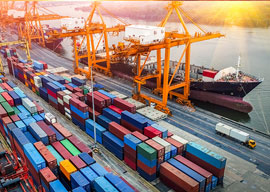The customized Tanzania Import Data Exim provides offers a full perspective of the nation’s trade market. Tanzania import data is a systematic record of research data and information sourced by the field of experts to assist businesses and traders in their various business-related operations.
Get access to Tanzania’s historic data and gain insights into the top imported and exported products of this country and know the exact HS Code for trade accuracy through Exim customized import-export trade data.
Discover new market places in the overseas markets and find new potential active buyers and suppliers for your foreign import-export trade business and stay ahead of your potential rivals in the global trade market.
Tanzania’s Complete Shipment Analysis Reports And Total Trade Value Throughout the Year
➢ The total trade value of Tanzania imports in the year 2017 was recorded at $9.12 billion.
➢ The total trade value of Tanzania imports in the year 2018 was recorded at $10.21 billion.
➢ The total trade value of Tanzania imports in the year 2019 was recorded at $10.36 billion.
➢ The total trade value of Tanzania imports in the year 2020 was recorded at $9.55 billion.
Buy systematic reports of Tanzania Import Data Year-Wise and gain crucial insights into the current and past import-export trade events that take place in Tanzania to form a better and strong marketing strategy for your global trade business.
Exports
➢ The total trade value of Tanzania exports in the year 2017 was recorded at $8.07 billion.
➢ The total trade value of Tanzania exports in the year 2018 was recorded at $8.40 billion.
➢ The total trade value of Tanzania exports in the year 2019 was recorded at $9.79 billion.
➢ The total trade value of Tanzania exports in the year 2020 was recorded at $8.92 billion.
Current Trade Statistics of Tanzania
➢ Trade Balance of Tanzania as of Sep 2021: $-562.30 million.
➢ Current Account of Tanzania as of Sep 2021: $-340.70 million.
➢ Total Imports Value of Tanzania as of Sep 2021: $2394.00 million.
➢ Total Exports Value of Tanzania as of Sep 2021: $1962.80 million.
What are the top products Tanzania Exports from other countries?
Tobacco & Manufactured Substitutes $201.4 million (3.9%), Fish $152.4 million (2.9%), Precious Metals & Gems $1.7 billion (32.6%), Fruits & Nuts $416.5 million (8%), Copper $476.3 million (9.1%), Spices, Tea & Coffee $210.6 million (4%), Oilseeds $262.8 million (5%), Cereals $157.1 million (3%), Vegetables $219.8 million (4.2%), Ash, Ores & Slag $416.9 million (8%) were the top export commodities of Tanzania according to Tanzania Export Data 2020 and trade statistics. Buy Tanzania import-export customs reports and gain full access to the trade strategies importers and exporters use for their global trade business as well as get a hold of all the authorized HS Codes required for specific products to increase trade accuracy in overseas markets.
The market intelligence reports of Exim trade data help you connect with the companies that match your business profile as per the requirements of your services. Exim’s customized market research reports help you compare prices and taxes on the global level and assist you in your several business-related decisions. Get instant access to thousands of systematic market analysis reports and custom trade data and stay updated with the current market flow of the global trade market.
For more info, you can connect to us directly or visit our official website for a quick and on-point overview of your current import-export trade statistics and strategies.








